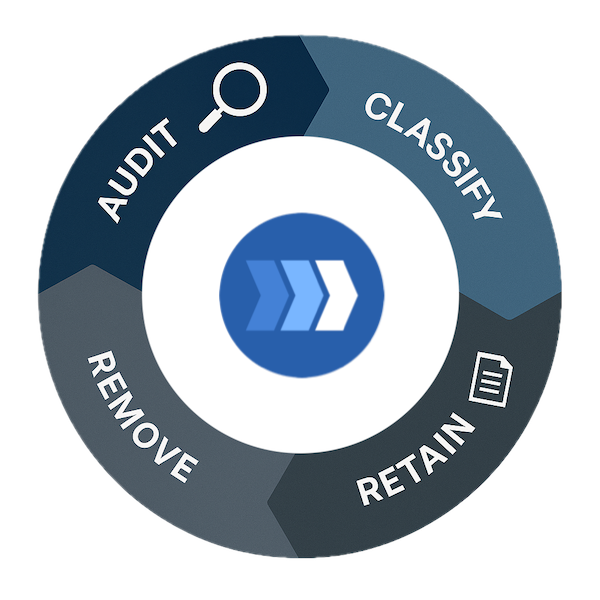Elevate Service Excellence: Govern Tickets, Assets, Knowledge, and PII with ease
Position your service organization to resolve faster, cut ticket noise, and keep Atlassian Jira Service Management, Customer Management, and Platform Assets clean, governed, and audit‑ready.
PII-ready governance for Atlassian Cloud service management teams
With Opus Guard, you turn content clutter into a governance advantage: automated retention, PII‑aware classification, holds, defensible deletion, and immutable evidence across Atlassian Jira Service Management, Atlassian Customer Management, and Atlassian Platform Assets. Whether you run internal ITSM or external CSM, you’re responsible for the quality, currency, and sensitivity of service data: tickets, change records, post‑incident reviews, KBs, asset histories, approvals, and customer conversations. Left unmanaged, that content becomes a cost center and a PII compliance liability.
Deploy Opus Guard's Content Retention Manager and give your service teams policy‑driven control that improves resolution speed, reduces PII footprint, enables trustworthy AI, and stands up to any audit.
Why this matters now more than ever
The key outcomes of modern data retention strategy
- Granular retention & classification: Align policies to ITIL practice areas, ticket types, asset classes, queues, and sensitivity (PII vs. non‑PII, privileged notes), so lifecycle controls match risk and privacy expectations.
- PII_aware governance: Identify and classify content with personal data, apply stricter retention windows, and reduce exposure by defensibly deleting outdated PII while preserving required operational records.
- Service‑Hold / Exception Workflows: Suspend deletion for security incidents, customer disputes, or audit periods—preserving evidence and avoiding spoliation until closure.
- Cost efficiencies: Cut backup object storage and indexed‑objects growth with double‑digit volume reductions. Reduce AI token overage costs with cleaner, smaller training sets and context windows. Improve Jira and Assets performance by keeping them leaner.
- Automation & Delegated Administration for Scale: Ideal for orgs with thousands of tickets, KB pages, and asset records; reduces manual cleanup burden and keeps platform performance high.
- Compliance‑Ready Infrastructure: SOC 2 and ISO 27001/42001 aligned, with no off‑platform data copies anywhere. Support data residency and privacy principles of minimization and storage limitation with confidence.
How Content Retention Manager solves it
Opus Guard's Content Retention Manager implements data retention strategy for high tech/high value IP, with ease.
Automate retention policies
Define and automate time- and event-based rules for spaces and projects (e.g., 2 years after incident close date), by queue, project, KB space – tightening the windows for PII.Delegate governance
Set up any number of groups of trained content admins, and let service owners or compliance review, hold, or extend before any deletion occurs; keeping human oversight on sensitive records.Discover, audit, classify, report
Classify content at scale (including PII vs. non‑PII), generate immutable proof of deletion, and show policy alignment to examiners or customers without scrambling. Immutable, exportable proof of deletion & policy alignment for any examiners – legal or audit.

Accelerate AI data-readiness
Clear out‑of‑date tickets and KBs so Jira Service Management agent‑assist, chatbots, and analytics use clean, current, low‑risk inputs – raising CSAT and lowering handle time.Align classification to frameworks
Map retention to ITIL practice areas and operational expectations, with hierarchical types and policies that honor privacy‑by‑design.Archive before deletion
Preserve governed records for required periods, then defensibly delete; balancing evidentiary needs with data minimization.Built for high-tech compliance
SOC 2, ISO 27001 & ISO 42001 (AI governance)alignment for dataset lineage, minimization, and exportable evidence trails.
Featured customers
Content Retention Manager walkthrough
FAQ's
Why should Service Management teams adopt a content‑retention platform?
Does automating retention and deletion increase risk?
Is Opus Guard's Content Retention Manager an ITSM tool?
Can we pilot this with a single queue or KB first?
How does Opus Guard fit in our existing information governance program?
Does this help Rovo and Glean?

Easy content governance
Content Retention Manager is your vital tool to oversee and execute the document lifecycle, ensuring that information is stored, maintained, and disposed of in a compliant focused manner and according to your defined retention policies.
"Love it. I've always wondered why this wasn't a feature in Confluence and now I found a way to get it!"
Opus Guard is your trusted retention partner
Opus Guard is SOC 2 Type II certified. And built entirely on Atlassian's own SOC 2 certified infrastructure. We regularly conduct tests and audits, subject to our controls.

Runs on Atlassian is a special category of apps in the Atlassian Marketplace that are built on Atlassian Forge. These apps • Are hosted on Atlassian’s platform • Store data within Atlassian • Are data residency compliant

Atlassian Cloud Fortified apps offer additional security, reliability, and support through: • Cloud security participation • Timely reliability checks • 24hr support response time, and more: verified by Atlassian
Data Residency & Privacy
Supports Atlassian data residency. Aligns to GDPR/CCPA principles of data minimization and storage limitation—no off-platform copies.
Defensible Deletion & Evidence
Policy-driven archival and deletion with exportable audit logs for regulatory reviews.
Least-Privilege by Design
Scopes limited to the minimum required to classify, audit, archive, and delete in Confluence & Jira.
ISO Alignment
Governance aligned with ISO 27001 (information security) and ISO 42001 (AI governance) practices.













